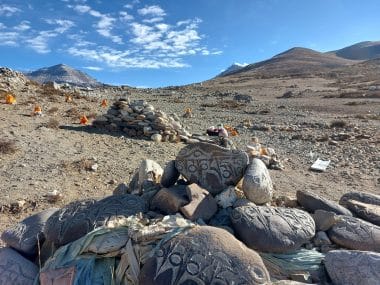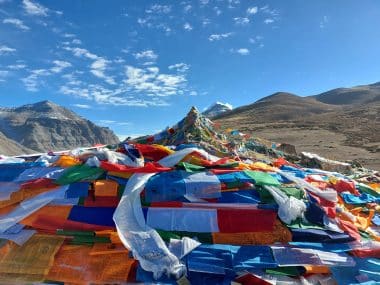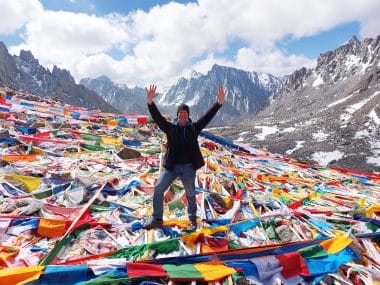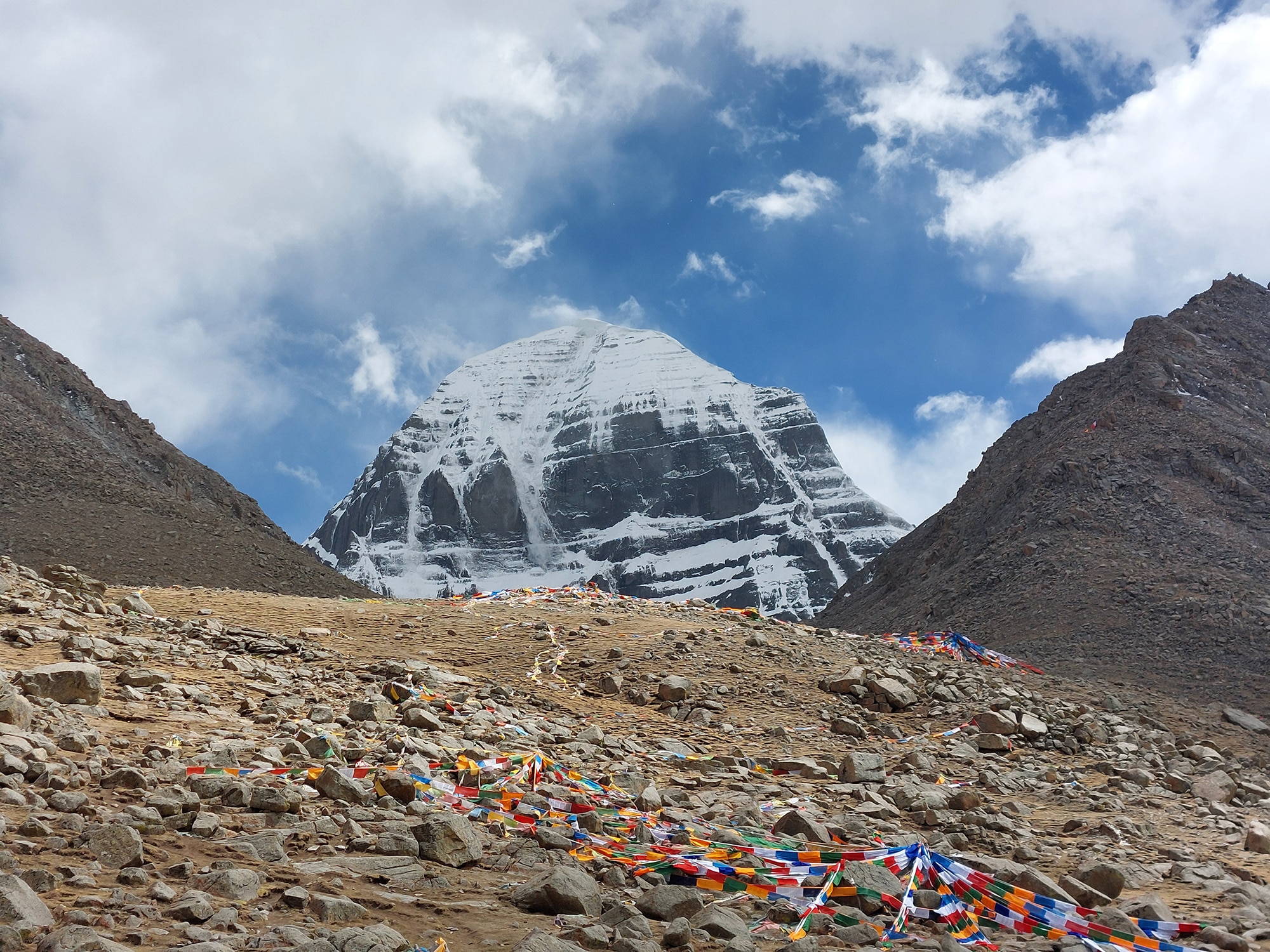by Thomas Bauer
The holy mountain Kailash is considered the soul of Tibet.
Travel book author Thomas Bauer (you can find more information about Thomas Bauer in our article from 2022) has circumnavigated it on foot.
He talks about police checks, panic attacks and the attraction of pilgrimage.
Itis astonishing that hardly anyone in this country knows Kailash.
After all, this Tibetan mountain is sacred for a fifth of the world’s population.
To this day, no one has stood on its summit.
Four rivers have their source in its vicinity, on whose waters the whole of South Asia depends: the Brahmaputra, the Indus, the Satluj and the Karnali, which flows into the Ganges.
Circumnavigating this mountain – 54 kilometers on foot on the so-called Kora – not only provides an unadulterated view of the Tibetan way of thinking, but also, according to popular belief, cleanses of all sins.

For 18 years, Kailash called me for a Kailash circumnavigation . I have always been fascinated by places where people have the hope of experiencing something extraordinary. But the remoteness of this area, the ingenuity of the Chinese bureaucracy and, most recently, the Corona-related isolation of Tibet had stood in my way so far. Only since January 2024 has a visa-free short trip through Tibet been possible for Germans. However, I have to get to Kailash first. And in my case, that requires a strenuous journey from Tibet’s capital Lhasa to close to the border with India and Nepal – 1,300 kilometers over a treeless, dust-dry plateau. At some point on this journey, I stop counting the police checks. They sometimes last several hours, and my “Tibet permit” plays a major role: a document that I had to apply for weeks in advance. On the back of it, I am asked to put a good face on the bad game: “Please keep a relaxed and happy mood!”.
But then I’m standing right in front of the mountain – and that’s almost unbelievable.
After all, I am in Darchen, the starting point of the mountain circuit, and thus almost at the height of Mont Blanc.
An almost mystical place, which is why my spelling program logically asks me: “Do you mean: dragon?”.
Yes, that’s probably exactly what I mean.
At least I wouldn’t be surprised if such an animal flew past here – started from the two-thousand-meter-towering snow-covered pyramid that rises right next to the village.
How to get there: via Lhasa or Kathmandu.
Since January 2024, Germans have been able to stay in China for up to two weeks without a visa.
A special permit is required for Tibet, which is provided by most tour operators.
Otherwise, you can apply for it online a few weeks in advance.
Best time to visit: May/June, when the Saga Dawa Festival takes place.
In the (long) Tibetan winter, however, many routes are impassable.
Tour operators: In Germany, among others, Diamir (www.diamir.de), schulz aktiv reisen (www.schulz-aktiv-reisen.de) & Hauser Excursions (www.hauser-exkursionen.de).
In China, Amazing Tibet (www.amazing-tibet.com) & Tibet Travel (www.tibettravel.org)
Procedure: An open-jaw flight Lhasa/Kathmandu is recommended in order to really “take along” all the special features on the way.
Highlights include the Potala Palace in Lhasa, the Tibetan monasteries of Drepung and Sera, the bustling metropolis of Kathmandu and Everest Base Camp with a view of the highest mountain on earth.
The journey of several days contributes to acclimatization.
The circumnavigation itself is 54 kilometers long and usually takes three days.
Some locals make the route in just one day.

Standards: esp.
not as usual on the circumnavigation of the mountain.
The accommodations are simple, there is food in particular. tsampa, the notorious gesture porridge, to drink butter tea.
In Darchen and in larger cities such as Lhasa and Shigatse, on the other hand, there are good Tibetan and Chinese restaurants.
Further information: Adventurer Thomas Bauer has published 14 books about his tours.
Recently published: “Curiosity about the World. In 80 Riddles around the Earth”, Periplaneta Verlag, Berlin.
More information about the book: https://www.periplaneta.com/neugier-auf-die-welt/
When the sun is shining, the thermometer climbs to twenty degrees Celsius.
Clouds, on the other hand, often bring snow.
Several times an hour I put my jacket on and off again.

The level of dedication dwarfs anything I’ve experienced so far.
I sometimes see “Western” adventurers with state-of-the-art equipment: thermal pants, waterproof ultralight jackets and height-adjustable hiking poles.
The real pilgrims, however, are the Tibetans in their worn-out clothes, but with traditional equipment: faith, the ability to suffer and unshakable trust.
Quite a few of them complete the kora by prostration: they lie flat on the ground, then take three steps to the place where their hands lay, bow down to the mountain there and lie down again.
They murmur prayers incessantly.
It will take them three weeks to circumnavigate Kailash in this way.
Compared to these pilgrims, I am a bungler who begins to tremble at the first gust of wind.
Nevertheless, I also feel the power that emanates from this mountain.
Sometimes its crest floats in the clouds, sometimes it shines so glaringly that I am tempted to reach out to touch it.
On the entire pilgrimage the Kailash is at my side.
The likes of us would probably have “climbed” it straight away and put a flag in it as proof of our own greatness.
By walking around it, on the other hand, we show it respect.
Long before we were the Kailash there, and it will still be when our bodies have long since crumbled to dust – or, as here, ground up and given to the vultures to eat.
The headache begins after a good four hours.
The sun is all too bright, I can hardly look up.
From the inside, a sadistic male knocks on my forehead with a hammer.
My heart jumps around in the body as if it wants to get out.
The ground under my legs blurs, moves like a sea.
The colors of the prayer flags, the singsong of the believers – all of this flows into each other, glued together to form a noise that settles in my ears.
On the right hand side I recognize a rock, and before my consciousness can follow, I have sat down on it.
A short time later, someone holds out a cup to me.
Butter tea, that, too: the greasy broth that is created by pouring tea boiled for hours into a barrel of salted yak butter and then stamping around in it.
In Tibet, children already drink it for breakfast.
A short time later I am ready to move on, but from here on I have to take a break every ten minutes.
Suddenly panic rises in me, I feel trapped on this seemingly endless plateau.
With a bang I reach my destination for today: a barrack on which someone has written the word “hotel” like a successful joke.
Before I go to sleep, I put on everything I’ve brought with me.
Although it is minus twenty degrees even inside, I manage to sleep until three o’clock, then gloomy forebodings wake me up: tomorrow I have to cross the Dolma La Pass, the highest point of the mountain circuit.
Would I be able to do that?
Would I even notice if it became dangerous?
To what extent is it worth fighting, but when would it be more advisable to turn back?

Thomas Bauer at the highest point of the mountain circuit, Image: Thomas Bauer
Restlessly, I get up and step out.
In front of me, massive and incorruptible, rises the Kailash.
I imagine that he is giving me a task.
Up here there is no cell phone reception and no alpine club to get you off the mountain in case of doubt.
Here I experience my own fragility, which is what makes me appreciate life anew.
I can and must let myself go, surrender completely to the kora and feel a power that reaches beyond me, which, if things go well, catches me.
That’s what I’m here for, I’ve been waiting for this for 18 years.
And yet: not an easy task for a “Westerner”!
The following morning, the mountain looks friendlier.
Its summit shines red yellow in the rising sun.
I take this as a good omen and force myself to carefully take one step in front of the other – always a little slower than I actually could.
The route points emphatically upwards.
Several times I slip on the frozen path sprinkled with boulders, glide down the slope and have to climb up the route I have just mastered again.
Nevertheless, I manage to let go: I forget the time, forget the way myself and surrender to the play of the clouds with the sun, the loose stream of pilgrims and the murmur of Tibetan sentence fragments.
So it is only when the mood around me brightens and strange pilgrims pat me on the shoulder that I realize that I have reached the holiest place of the Kora.
In the obligatory summit photos, I grin like a honey cake horse.
This is followed by a six-hour descent and another rustic overnight stay before a wide valley takes me back to Darchen.
At the side of the road I keep seeing stones with the incantation “Om Mani Padme Hum”, which someone carried over the pass and then deposited here.
Kailash greets us friendly from the right.
He gave me a lot, made sure that I anchored myself anew and was able to concentrate on the essentials again.
It is probably what we need most in our everyday life with its all too tangible distractions.
But at the same time, this mountain has shown me a limit: In this lifetime, I will probably not climb higher than 5,698 meters.
I don’t have to.
The mountain is in me now.


